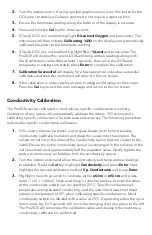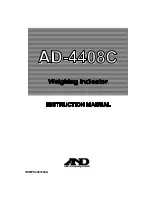
Installing the DO Membrane
The DO sensor is shipped with a red protective cap covering the electrodes. A new cap
membrane with electrolyte must be installed on the DO sensor prior to use.
1.
Prepare the electrolyte solution according to the instructions on the bottle.
2.
Remove and discard the red protective cap or used cap membrane from the
sensor.
3.
Thoroughly rinse the sensor tip with distilled or deionized water.
4.
Fill a new cap membrane with electrolyte solution. Avoid touching the
membrane portion of the cap.
5.
Thread the cap membrane onto the sensor, moderately tight. A small amount of
electrolyte will overflow.
6.
Install the probe sensor guard.
Barometer Calibration
The barometer reading must be accurate to ensure accurate DO % calibrations and DO
readings. If the instrument’s barometer requires an adjustment:
Determine your local barometric pressure (BP) from a barometer, an independent
laboratory or from a local weather service. If the BP reading has been corrected to sea
level, use the following equation to determine the true BP in mmHg for your altitude:
True BP = (Corrected BP in mmHG) – {2.5 * (Local Altitude in feet/100)}
1.
From the Run screen, use the up or down arrow keys to highlight the barometer
box then press
Enter
.
2.
Use the up or down arrow keys to adjust the barometer reading to the local, true
barometric pressure.
3.
Press
Enter
to confirm and save the barometer adjustment.
DO Calibration
The Pro2030 can be calibrated in % saturation, mg/L or ppm. Calibration of any option
(%, mg/L, or ppm) will automatically calibrate the others. The Pro2030 can be calibrated
with the press of a few keys when Quick DO Cal is enabled in the System Setup menu.
The following procedure outlines the % saturation calibration option with and without
Quick DO Cal enabled.
1.
Moisten the sponge in the cal/transport sleeve with a small amount of water and
install it on the probe.
Make sure the DO and temperature sensors are not
immersed in the water.






















